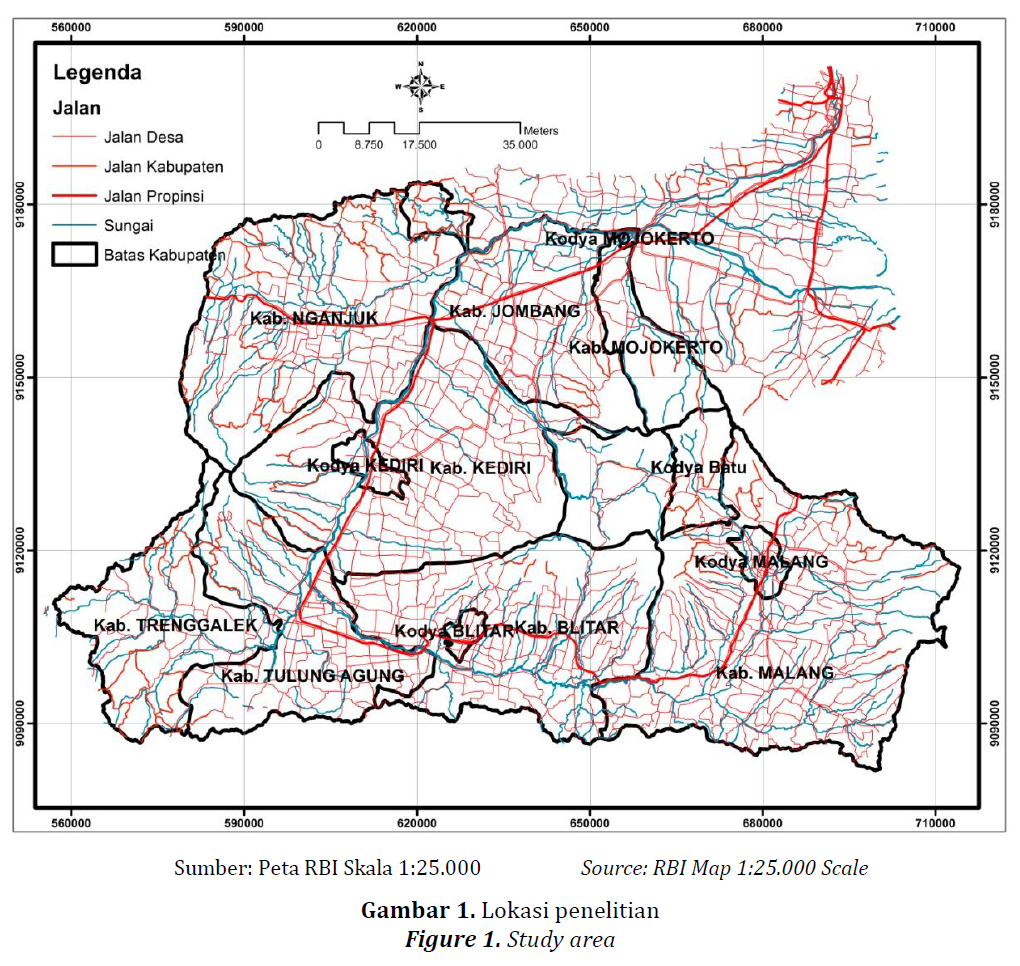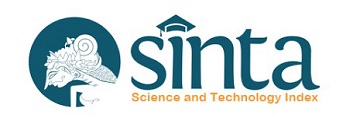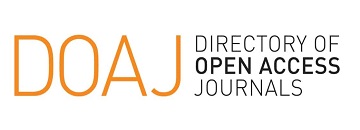Degraded Land Analyses of Brantas River Basin to Support Land Rehabilitation

Downloads
Downloads
Anwar, M., Pawitan, H., Murtilaksono, K., &Jaya, I. N. S. (2011). Respons Hidrologi Akibat Deforestasi di DAS Barito Hulu, Kalimantan Tengah. Jurnal Manajemen Hutan Tropika XVII(3), 119-126.
Asdak, C. (Ed.). (2010). Hidrologi dan Pengelolaan Daerah Aliran Sungai. Yogyakarta: Gadjah Mada University Press.
Barrio, P. O. D., Giménez, R., & Campo-Bescós, M. Á. (2017). Assessing Soil Porperties Controlling Interrill Erosion: An Empirical Approach Under Mediterranean Condition. Land Degrad. Develop., 28, 1729-1741. doi: DOI: 10.1002/ldr.2704
Devianti. (2018). Kajian Tingkat Laju Limpasan Permukaan dan Erosi Berdasarkan Pengelolaan Tanaman Pertanian Sistem Agroforestry di DAS Cianten-Cipancar, Provinsi Jawa Barat, Indonesia. JTEP Jurnal Keteknikan Pertanian, 6(1), 109-116. doi: DOI: 10.19028/jtep.06.1.109-116
Direktorat Jenderal Pengendalian Daerah Aliran Sungai dan Hutan Lindung.(2018). Petunjuk Teknis Penyusunan Data Spasial Lahan Kristis, Pub. L. No. P.3/PDASHL/SET/KUM.1/7/2018. Jakarta: Kementerian Lingkungan Hidup dan Kehutanan.
DirektoratJenderal Reboisasi dan Rehabilitasi Lahan. (1995). Pedoman Penyusunan Rencana Teknik Lapangan Rehabilitasi Lahan dan Konservasi Tanah Daerah Aliran Sungai. Jakarta: Balai Pengelolaan Daerah Aliran Sungai Jeneberang-Walanae Makassar, Direktorat Jenderal Reboisasi dan Rehabilitasi Lahan.
DirektoratKehutanan dan Konservasi Sumber Daya Air. (2012). Analisa Perubahan Penggunaan Lahan di Ekosistem DAS dalam Menunjang Ketahanan Air dan Ketahanan Pangan: Studi Kasus DAS Brantas In BAPPENAS (Ed.). Jakarta: BAPPENAS.
Du, Z.-L., Zhao, J.-K., Wang, Y.-D., & Zhang, Q.-Z. (2017). Biochar addition drives soil aggregation and carbon sequestration in aggregate fractions from an intensive agricultural system. J Soils Sediments 17, 581-589. doi: DOI 10.1007/s11368-015-1349-2
Duan, X., Xie, Y., Ou, T., & Lu, H. (2011). Effects of Soil Erosion on Long-term Soil Productivity in The Black Soil Region of Northeastern China. Catena, 87, 268-275.
Ferreira, V., Panagopoulos, T., Andrade, R., Guerrero, C., &Loures, L. (2015). Spatial variability of soil properties and soil erodibility in the Alqueva reservoir watershed. Solid Earth, 6, 383-392.
Geissler, C., Kühn, P., Böhnke, M., Bruelheide, H., Shi, X., & Scholten, T. (2012). Splash Erosion Potential underTree Canopies in Subtropical SE China. CATENA, 91, 85-93.
Hendra, T. L. (2013). Dampak Perubahan Penggunaan Lahan terhadap Tingkat Kekritisan Air Sub DAS Citarum Hulu. Majalah Geografi Indonesia, 27(1), 26-37.
Herawati, T. (2010). Analisis Spasial Tingkat Bahaya Erosi di Wilayah DAS Cisadane Kabupaten Bogor. Jurnal Penelitian Hutan dan Konservasi Alam, VII (4), 413-424.
Junaidi, E. (2013). Peranan Penerapan Agroforestry terhadap Hasil Air Daerah Aliran Sungai (DAS) Cisadane. Jurnal Penelitian Agroforestry, 1(1), 41-53.
Junaidi, E., & Indrajaya, Y. (2018). Respon hidrologi akibat penerapan pola agroforestri pada penggunaan lahan yang tidak sesuai kesesuaian lahan Jurnal Penelitian Kehutanan Wallacea, 7(1), 69-81.
KementerianLingkungan Hidup dan Kehutanan. (2017). Statistik Lingkungan Hidup dan Kehutanan Tahun 2016. Jakarta: Pusat Data dan Informasi, Sekretariat Jenderal Kementerian Lingkungan Hidup dan Kehutanan
Khare, D., Mondal, A., Kundu, S., &Mishra, P. K. (2017). Climate change impact on soil erosion in the Mandakini River Basin, North India. Appl Water Science, 7, 2373-2383. doi: DOI 10.1007/s13201-016-0419-y
Kurnia, U., Sutrisno, N., & Sungkawa, I. (2010). Perkembangan Lahan Kritis. In K. Suradisastra, S. M. Pasaribu, B. Sayaka, A. Dariah, I. Las, Haryono & E. Pasandaran (Eds.), Membalik Kecenderungan Degradasi Sumber Daya Lahan dan Air(pp. 143-160). Bogor: IPB Press.
Kurnia, U., & Suwardjo. (1984). Kepekaan Erosi Beberapa Jenis Tanah di Jawa menurut Metode USLE. Pemberitaan Penelitian Tanah dan Pupuk, 3, 17-20.
Lipu, S. (2010). Analisis Pengaruh Konversi Hutan terhadap Larian Permukaan dan Debit Sunia Bulili, Kabupaten Sigi. Media Litbang Sulteng, 3(1), 44-50.
Mashudi, Susanto, M., & Baskorowati, L. (2016). Potensi Hutan Tanaman Mahoni (Swietenia macrophyllaKing) dlam Pengendalian Limpasan dan Erosi. J. ManusiadanLingkungan, 23(2), 259-265.
MenteriKehutanan Republik Indonesia. (2009). Keputusan Menteri Kehutanan Nomor: SK.328/Menhut-II/2009 tentang Penetapan Daerah Aliran Sungai (DAS) Prioritas dalam Rangka Rencana Pembangunan Jangka Menengah (RPJM) Tahun 2010-2014). Jakarta.
Ming, L., Yu-kuan, W., Pei, X., Bin, F., Cong-shan, T., & Shan, W. (2018). Cropland physical disturbance intensity: plot-scale measurement and its application for soil erosion reduction in mountainous areas Journal of Mountain Science 15(1), 198-210. doi: https://doi.org/10.1007/s11629-017-4574-x
Moges, DesalewM., & H.GangadharaBhat. (2017). Integration ofgeospatial technologies withRUSLE foranalysis ofland use/cover change impact onsoil erosion: case study inRib watershed, north western highland Ethiopia. Environ Earth Sci 76, 765. doi: DOI 10.1007/s12665-017-7109-4
Mondal, A., Khare, D., & Kundu, S. (2016). Impact assessment of climate change on future soil erosion and SOC loss. Nat Hazards 82, 1515-1539. doi: DOI 10.1007/s11069-016-2255-7
Mukherjee, A., & Lal, R. (2013). Biochar Impacts on Soil Physical Properties and Greenhouse GasEmissions Agronomy, 3, 313-339. doi: doi:10.3390/agronomy3020313
Munibah, K., Sitorus, S. R. P., Rustiadi, E., Gandasasmita, K., & Hartrisari. (2010). Dampak Perubahan Penggunaan Lahan Terhadap Erosi di DAS Cidanau, Banten. Jurnal Tanah dan Iklim, 32, 55-69.
Naik, S. K., Maurya, S., & Bhatt, B. P. (2017). Soil organic carbon stocks and fractions in different orchards of eastern plateau and hill region of India. Agroforest Syst., 91, 541-551. doi: DOI 10.1007/s10457-016-9957-4
Olivares, B., Verbist, K., Lobo, D., Vargas, R., & Silva, O. (2011). Evaluation of The USLE Model to Estimate Water Erosion in an Alfisol. J. Soil Sci. Plant Nutr., 11(2), 71-84.
Olivi, R., Qurniati, R., & Firdasari. (2015). Kontribusi Agroforestri terhadap Pendapatan Petani Desa Suoharjo Kecamatan Sukoharjo Kabupaten Pringsewu. Jurnal Sylva Lestari, 3(2), 1-12.
Ozsahin, E., Duru, U., & Eroglu, I. (2018). Land Use and Land Cover Changes (LULCC), a Key to Understand Soil Erosion Intensities in the Maritsa Basin. Water 10(3),1-15. doi:10.3390/w10030335
Paningbatan Jr., E. P. (2001). Hydrology and Soil Erosion Models for Catchment Research and Management. In A. R. Maglinao & R. N. Leslie (Eds.), Soil Erosion Management Research in Asian.
Phama, T. G., Degener, J., &Kappas, M. (2018). Integrated universal soil loss equation (USLE) and Geographical Information System (GIS) for soil erosion estimation in A Sap basin: Central Vietnam. International Soil and Water Conservation Research 6, 99-110.
Rees, F., Dhyèvre, A., Morel, J. L., & Cotelle, S. (2017). Decrease in the genotoxicity of metal-contaminated soils with biochar amendments. Environ Sci Pollut Res 24, 27634-27641. doi: DOI 10.1007/s11356-017-8386-x
Rhoades, J. L., Demyan, M. S., & Orr, B. (2011). Impacts of Deforestation and Land Cover Change on Mountain Soils in Hrazdan, Armenia. Journal of Sustainable Forestry, 30, 677-696.
Santi, L. P. (2017). Pemanfaatan Biochar Asal Cangkang Kelapa Sawit untuk Meningkatkan Serapan Hara dan Sekuestrasi Karbon pada Media Tanah Lithic Hapludults di Pembibitan Kelapa Sawit. Jurnal Tanah dan Iklim 41(1), 9-16.
Sharma, A., Tiwari, K. N., & Bhadoria, P. B. S. (2011). Effect of Land Use Land Cover Change on Soil Erosion Potential in an Agricultural Watershed. Environ Monit Assess,173, 789-801.
Sigalos, G., Loukaidi, V., Dasaklis, S., Drakopoulou, P., Salvati, L., Ruiz, P. S., & Mavrakis, A. (2016). Soil erosion and degradation in a rapidly expanding industrial area of Eastern Mediterranean basin (Thriasio plain, Greece). Nat Hazards, 82, 2187-2200. doi: DOI 10.1007/s11069-016-2288-y
Tombus, F. E., Yuksel, M., Sahin, M., Ozulu, İ. M., & Cosar, M. (2012). Assessment Of Soil Erosion Based On The Method USLE; Çorum Province: Example Rome, Italy: TS05E -Technical Aspects of Spatial Information II, 5848.
Wahyuningrum, N., & Wardojo. (2008). Analisis Kemampuan Lahan di Sub DAS Tajum.Paper presented at the Seminar Nasional Hasil Penelitian “Teknologi, Sosial Ekonomi dan Kelembagaan Sebagai Basis Pengelolaan DAS Purwokerto.
Wahyunto, & Dariah, A. (2014). Degradasi Lahan di Indonesia: Kondisi Existing, Karakteristik, dan Penyeragaman Definisi Mendukung Gerakan Menuju Satu Peta Jurnal Sumberdaya Lahan 8(2), 81-93.
Weischmeier, W. H., & Smith, D. D. (1978). Predicting Rainfall Erosion Losses; A Guide to Conservation Planning. Agriculture Handbook, 537, 1-59.
Widianto, Suprayogo, D., Sudarto, & Lestariningsih, I. D. (2010) Implementasi Kaji Cepat Hidrologi (RHA) di Hulu DAS Brantas, Jawa Timur. (pp. 1-133). Bogor: World Agroforestry Centre, ICRAF Southeast Asia Regional Office
Xu, G., Lu, K., Li, Z., Li, P., Wang, T., & Yang, Y. (2015). Impact of soil and water conservation on soil organic carbon content in a catchment of the middle Han River, China. Environ Earth Sci, 74, 6503-6510.








